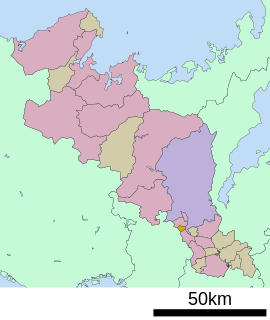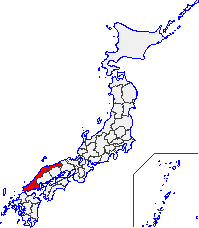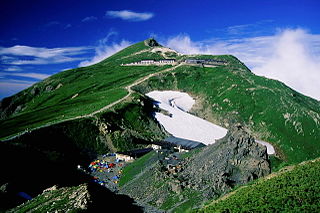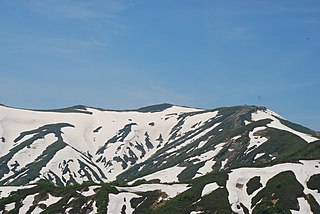See also
| This disambiguation page lists articles associated with the title Ōeyama. If an internal link led you here, you may wish to change the link to point directly to the intended article. |
Ōeyama, Ooeyama or Mount Ooe may refer to:
| This disambiguation page lists articles associated with the title Ōeyama. If an internal link led you here, you may wish to change the link to point directly to the intended article. |

The Nakasendō, also called the Kisokaidō (木曾街道), was one of the five routes of the Edo period, and one of the two that connected Edo to Kyoto in Japan. There were 69 stations (staging-posts) between Edo and Kyoto, crossing through Musashi, Kōzuke, Shinano, Mino and Ōmi provinces. In addition to Tokyo and Kyoto, the Nakasendō runs through the modern-day prefectures of Saitama, Gunma, Nagano, Gifu and Shiga, with a total distance of about 534 km (332 mi).

Ōyamazaki is a town located in Otokuni District, Kyoto Prefecture, Japan.
The Three Views of Japan is the canonical list of Japan's three most celebrated scenic sights, attributed to 1643 and scholar Hayashi Gahō. In 1915, modeled on the old Three Views of Japan, Jitsugyo no Nihon Sha (株式会社実業之日本社) held a national election to determine a list of New Three Views of Japan. The Three Major Night Views of Japan is the canonical list of Japan's three most celebrated scenic night views. In April 2003, the New Three Major Night Views of Japan and the 100 Night Views of Japan Club (新日本三大夜景・夜景100選事務局), a nonprofit organization, formed a selection committee and, together with its members, selected by vote the New Three Major Night Views of Japan (新日本三大夜景), modeled on the traditional list of Three Major Night Views of Japan. In August 2004, they also announced the 100 Night Views of Japan (夜景百選).
Sun Television Co. is a commercial television station headquartered in Kobe, Hyōgo Prefecture, Japan, and a member of the Japanese Association of Independent Television Stations (JAITS).

The Tanzawa Mountains are a mountain range in the Kantō region, in Japan. It covers the northwestern part of Kanagawa Prefecture and touches the prefecture borders of Shizuoka Prefecture to the west and the Yamanashi Prefecture to the north.

Jōshin'etsu-kōgen National Park is a national park in the Chūbu region of the main island of Honshū, Japan formed around several active and dormant volcanoes. It spans the mountainous areas of Gunma, Nagano, and Niigata prefectures. The name refers to the two mountain ranges that make up the park. It was divided into two separate areas: the Southern Niigata/North Nagano Area and the East Nagano Area.

The San'in Region is an area in the southwest of Honshū, the main island of Japan. It consists of the northern part of the Chūgoku region, facing the Sea of Japan.

Chūgoku Mountains is a mountain range in the Chūgoku region of western Japan. It runs in an east-west direction and stretches approximately 500 km (311 mi) from Hyōgo Prefecture in the east to the coast of Yamaguchi Prefecture. The range also reaches under the Pacific Ocean.
Sanjo Station may refer to the following railway stations in Japan:

Ōtoshi or Nigihayahi, commonly known: Toshigami or Ōtoshi is a Kami of the Shinto religion in Japan.

Mt. Shirouma is a peak in the Hida Mountains range of the Japanese Alps, located in Nagano Prefecture and Toyama Prefecture, central Honshu, Japan.

Mount Iide is the main peak of the Iide mountain range that spans the Fukushima, Niigata and Yamagata prefectures in Japan. On top of the mountain stands the Mount Iide Shrine (飯豊山神社). Mount Iide is, together with the rest of the range, one of the mountains described in Kyūya Fukada's book 100 Famous Japanese Mountains.

Tango-Amanohashidate-Ōeyama Quasi-National Park is a Quasi-National Park in northern Kyōto Prefecture, Japan. Established in 2007, the park comprises a number of non-contiguous areas of the former Tango Province, with a central focus on Mount Ōe (大江山) and Amanohashidate, one of the Three Views of Japan.

Kotohiki Beach is located in Kyōtango, Kyōto Prefecture, Japan. It is a nationally designated Natural Monument and Place of Scenic Beauty, and forms part of the Tango-Amanohashidate-Ōeyama Quasi-National Park. In 1996, the Ministry of the Environment selected the sound of the sands as one of the 100 Soundscapes of Japan.

Shuten-dōji is a mythical oni or demon leader of Japan, who according to legend was killed by the hero Minamoto Raikō. Although decapitated, the demon's detached head still took a bite at the hero, who avoided death by wearing multiple helmets stacked on his head.

Ōeyama, also known as Ooe-yama and Mount Ooe, is a mountain in Kyoto Prefecture, Japan. The mount is 480m high. The mountain is located in the boundary between Nishikyo Ward, Kyoto, and Kameoka. It is also called 大江山 (Ōeyama) or (大井山) Ōiyama (大井山). Oinosaka-toge Pass (老ノ坂峠) is located on the north-side slope of this mountain. In the past, the slope where pass of Mt. Oe was called 'Oeno-saka Slope' (大江坂), but is now referred to as Oino-saka Slope (老の坂). It is the most famous for the legend of Shuten-dōji, an oni. It is now the site of a ski resort, about 20 minutes by bus from Miyazu Station on the KTR Miyazu Line.
Ooe may refer to:

Mount Izumi Katsuragi is a mountain in the Kongō Range straddling the border between Osaka and Wakayama Prefectures in Japan. Its peak elevation is 858 metres (2,815 ft).

Mount Minami Katsuragi is the tallest mountain in the Izumi Mountains within the Kongō Range, straddling the border between Osaka and Wakayama Prefectures in Japan. Its peak elevation is 922 metres (3,025 ft).

Located at the base of the Tango Peninsula in Kyoto Prefecture, Ōeyama (大江山) mountain range extends over Yosano-cho, Fukuchiyama and Miyazu. The highest peak, Senjogatake (千丈ヶ嶽) has an elevation of 832.5 meters. The range is also called Yosa-no-oyama (与謝大山) and is the most known for the legend of Shuten-doji. It is also known for the sea of clouds that is visible from points of high elevation. On August 3, 2007, the mountain range was designated as a Quasi-National Park under the name Tango-Amanohashidate-Ōeyama Quasi-National Park.